Rifftides: February 2011 Archives
In my Modern Jazz Quartet project, I'm roundin' third and headin' home (for mystified readers in Brussels or Bangkok, that's a baseball metaphor). I hope to be back to more or less regular blogging early this week. In the next few days, the Rifftides staff will have news about a new look for the blog. In the meantime, why not share the MJQ wealth? In my research, I ran across this video made in London in 1982. Sigmund Romberg and the MJQ live!
What project? Go here.
The fine jazz photographer Ron Hudson died at his Seattle home on Tuesday. He was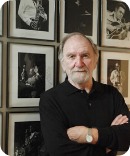 71. For more than 30 years, Hudson captured memorable images of Ella Fitzgerald, Miles Davis, Woody Herman, Milt Jackson, Bud Shank and dozens more of the leading musicians of his time. He worked exclusively in black and white and won admiration for the clarity of his prints. As noted in this Rifftides review of a book of his collected photographs, Hudson had the gift of anticipating a crucial stage in the act of improvisation and releasing his shutter at precisely the right millisecond. Most of his pictures were intimate action portraits, but he sometimes caught large groups in dramatic moments, as in this panoramic shot of a convocation of bassists a few years ago in a tribute to Ray Brown at the Centrum Port Townsend Jazz Festival.
71. For more than 30 years, Hudson captured memorable images of Ella Fitzgerald, Miles Davis, Woody Herman, Milt Jackson, Bud Shank and dozens more of the leading musicians of his time. He worked exclusively in black and white and won admiration for the clarity of his prints. As noted in this Rifftides review of a book of his collected photographs, Hudson had the gift of anticipating a crucial stage in the act of improvisation and releasing his shutter at precisely the right millisecond. Most of his pictures were intimate action portraits, but he sometimes caught large groups in dramatic moments, as in this panoramic shot of a convocation of bassists a few years ago in a tribute to Ray Brown at the Centrum Port Townsend Jazz Festival.
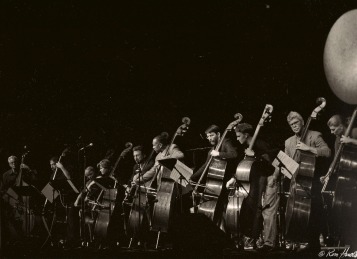
A 2006 Katy Bourne profile of the photographer on All About Jazz includes several of Hudson's photographs.
Many listeners know that Arturo O'Farrill is a talented New York pianist who leads Jazz at Lincoln Center's Afro-Latin Jazz Orchestra. He has been a considerable force in Latin 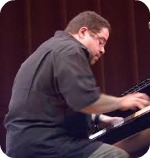 music in the US for three decades. Fewer may be aware that he is the son of Chico O'Farrill, a Cuban of Irish origin who was one of the most distinctive and versatile composers and arrangers in American jazz. In this week's Village Voice, Larry Blumenfeld tells the father's and son's stories in the context of Arturo's emotional trip to Havana with his mother and sons. He made the trip with full knowledge that anti-Castro Cubans in the US, including his friend Paquito D'Rivera, feel that any recognition of or cooperation with Cuba will be used by the Castro government as a propaganda weapon. From Blumenfeld's piece:
music in the US for three decades. Fewer may be aware that he is the son of Chico O'Farrill, a Cuban of Irish origin who was one of the most distinctive and versatile composers and arrangers in American jazz. In this week's Village Voice, Larry Blumenfeld tells the father's and son's stories in the context of Arturo's emotional trip to Havana with his mother and sons. He made the trip with full knowledge that anti-Castro Cubans in the US, including his friend Paquito D'Rivera, feel that any recognition of or cooperation with Cuba will be used by the Castro government as a propaganda weapon. From Blumenfeld's piece:
Arturo squints into the sun and explains that, late in his life, after his father's career had revived, Chico was ready to go back and play his music. He wanted to return. "But then his health took a really bad turn," Arturo says. "It became impossible. So I'm completing that trip for him." But this isn't just a personal matter, he explains. "I'm not interested in making light of the fact that Cuban politics is rife with corruption and political imprisonment. I'm also not delicate about communicating that America is a nation built on tremendous bloodshed and continuous imperialism. I don't think those are things that should be run from or ignored. They're just historical facts. Anybody who's half-awake in the world will understand the brutality of both sides. Music courses through and above all that. We need to connect, not disconnect."
Blumenfeld's lengthy article about O'Farrill's visit to his father's homeland has the flavor of a well-reported documentary. To read it, go here.
Blogging is going on the back burner—or maybe a side burner—for a few days while I wrap up an assignment. I am writing the essay and program notes for a seven-CD Mosaic box of the Modern Jazz Quartet's Atlantic studio recordings from 1956 to 1964. It involves a lot of listening, a lot of interviewing, a lot of work and an enormous amount of pleasure. This video from an MJQ concert in Holland in 1982 underlines the point about pleasure. The piece includes a splendid John Lewis solo, Connie Kay's irresistible time keeping and at the end, following Milt Jackson's dazzling vibes passage, something even rarer than the Percy Heath bass solo—what may be a smile from Jackson. Mr. Lewis announces the tune.
Percy Heath's work before and after that solo brings to mind this Rifftides archive item about the importance of the bass line to understanding the nature of a jazz performance. The first installment of a six-part series, it contains a bonus video from the MJQ and another solo by Percy. I'm told that the Mosaic box will be out in late spring or early summer.
I should have alerted you earlier to another web concert by the excellent Seattle Repertory Jazz Orchestra. It will be broadcast beginning at 1 pm (PST) today. Here are the details in an announcement from the SRJO.
Tune in to hear highlights of the SRJO's "Jazz Goes To the Movies" (recorded in November 2011) on the next Jazz Northwest on KPLU 88.5FM - KPLU. It's a concert of movie themes and incidental music played by the Seattle Repertory Jazz Orchestra. The concert, directed by Clarence Acox and Michael Brockman is part of the annual series presented by the SRJO. Mission Impossible, The Pink Panther, Days of Wine and Roses and other jazz from the movies is included...we'll even have some film clips (a rarity for radio!).Sunday, February 20 at 1 PM Pacific on Jazz Northwest on 88-5, KPLU and streamed live at kplu.org. Jazz Northwest is recorded and produced by Jim Wilke exclusively for KPLU. The program is also available as a podcast at kplu.org.
Sorry for the short notice; I'm buried in a Modern Jazz Quartet project that I'll tell you about later.
Bill Monroe died yesterday at the age of 90. You may remember him as the moderator of NBC's Meet The Press. He was noted for the toughness and fairness of his questioning in the years when that Sunday morning program influenced millions of Americans'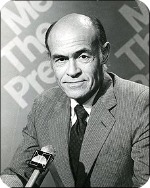 thinking about government and politics.
thinking about government and politics.
I remember him as the man who built the news department of WDSU-TV in New Orleans into a pioneer in early television news and a moderating force when the south was riven by the hatreds and tensions that accompanied the civil rights movement. By the time I joined WDSU in the 1960s, Monroe had moved on to be the Washington, DC, bureau chief for NBC, but WDSU's news operation continued in the tradition of integrity and professionalism that he established. When he came back to visit, I was privileged to get to know him.
In later years when I moved from reporting and anchoring to running news departments, Bill's example and occasional advice helped guide me. In this clip from the Emmy archives, he talks about one aspect of his early days at WDSU.
For an account of Monroe's career and contributions, see his obituary in The New Orleans Times-Picayune. This is the conclusion of his obituary in today's Washington Post:
Throughout his career, he was critical of the Federal Communications Commission's regulation of broadcast media - a first step, he said, toward abridging the constitutionally guaranteed rights of free speech and free press.
"The effect of government control on broadcast news is to make it bland, to inhibit it, to make it somewhat less courageous, less inclined to initiative than the print media," Mr. Monroe said in a 1980 interview. "The whole regulatory system is a monster that has done the public much more harm than good."
Let us hope that latter-day Bill Monroes—if we are fortunate enough to have some—continue to insist on preservation of that constitutional guarantee
Dave Frishberg will be featured this weekend at one of the main concerts of the Portland Jazz Festival. It's an unusual gig for Frishberg; he frequently plays piano in his adopted 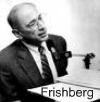 hometown but rarely sings his songs there. In Oregon Music News, Jack Berry opens his piece about Frishberg with a story of the time Frishberg got a startling surprise when he spotted an old friend. Here's a link.
hometown but rarely sings his songs there. In Oregon Music News, Jack Berry opens his piece about Frishberg with a story of the time Frishberg got a startling surprise when he spotted an old friend. Here's a link.
To see the PDX Jazz festival schedule, go here.
In today's Wall Street Journal, Terry Teachout writes about George Shearing's popularity. He finds it admirable. A sample observation:
Mr. Shearing's willingness to work both sides of the street vexed jazz critics, who are not an especially tolerant lot, and by the '60s he had been written off as a popularizer. In fact, though, he was something completely different, a dead-serious artist who enjoyed playing well-crafted music that was accessible to a popular audience.
To read the whole thing, go here.
As Teachout said this morning in a message, Marc Myers of JazzWax accomplished a coup when he tracked down Marjorie Hyams, the vibes player in the original Shearing quintet. She is 90 and has a great memory. To read Marc's interview with Ms. Hyams, go here.
You will find a Rifftides reflection on Shearing two exhibits down.
This is what dominates the sky tonight. The photograph snapped by an inadequate camera merely suggests its chilly magnificence.
 Hoagy Carmichael captured the mood the winter moon generates. This is from his 1956 album with the Pacific Jazzmen. Art Pepper has the first chorus on alto saxophone, with muted trumpet by Don Fagerquist. Jimmy Rowles is the pianist.
Hoagy Carmichael captured the mood the winter moon generates. This is from his 1956 album with the Pacific Jazzmen. Art Pepper has the first chorus on alto saxophone, with muted trumpet by Don Fagerquist. Jimmy Rowles is the pianist.
George Shearing died early today at the age of 91. With his quintet, Shearing used a locked-hands technique at the piano, blending with vibes and guitar to develop a style that resonated with listeners and became one of the most recognizable sounds in an era when jazz was still at the core of popular music. He was already a success because of his hit version of "September in the Rain" when the record of his 1952 composition "Lullaby of Birdland" solidified his popularity. The song also provided Shearing a reliable annuity; dozens of instrumentalists and singers incorporated it into their repertoires and recorded it.
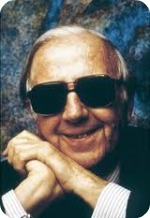 Shearing, born blind, had become widely known in his native England when he moved to the United States in 1947. He was an early admirer of Bud Powell and quickly adapted to the new strain of music that came to be known as bebop. He was a fleet and inventive improviser whose brilliance was sometimes taken for granted because of his band's popular success.
Shearing, born blind, had become widely known in his native England when he moved to the United States in 1947. He was an early admirer of Bud Powell and quickly adapted to the new strain of music that came to be known as bebop. He was a fleet and inventive improviser whose brilliance was sometimes taken for granted because of his band's popular success.
Fellow musicians recognized his gift. Shearing's contemporary Dave Brubeck, told the Associated Press today, "I consider him one of the greatest musical minds I've ever been around. In the '50s, George paved the way for me and the (Modern Jazz Quartet), and even today jazz players, especially pianists, are indebted to him."
To read all of the AP's Shearing obituary, click here.
When vibraharpist Charlie Shoemake joined Shearing in 1967, the other members were guitarist Joe Pass, bassist Bob Whitlock and drummer Colin Bailey. Shoemake stayed for seven years.
"He was tough if somebody wasn't up to par," Shoemake told me today, "but if you met his standards, he couldn't do enough for you. When you go to work six, seven nights a week with a great band like that, you're going to really improve. I had great admiration for him. Harmonically, I don't think that he had any peers; he was as brilliant as anybody I ever met. His touch and his voicings and his chord substitutions on songs were from the heavens. Bill Evans, of course, was very influenced by way he used block chords. Bill very openly admitted that he'd learned a lot of that from Shearing. With George, I went from being an anonymous studio musician to someone sort of well known as a jazz vibes player. All the guys who played for him loved him."
Here is Shearing in the early 1950s with his composition "Conception," which became a jazz standard. The quintet has Don Elliott, vibes; Chuck Wayne, guitar; Denzil Best, drums; and John Levy, bass.
George Shearing, RIP.
I just came across this video clip of George Shearing answering fellow pianist Billy Taylor's questions about how he developed the Shearing style. The clip has no date, but Taylor's leisure suit says the 1970s. The interested onlooker is Marian McPartland.
On his Jazz Profiles website, Steve Cerra begins a tribute to Bill Holman with this passage:
In Japan, a select few of those who maintain the country's artistic traditions or make a unique contribution to them are accorded the respect of the nation by beingdesignated as a Living National Treasure [a considerable amount of schimolies also come with the title each year].
When it comes to composing and arranging for Jazz big bands, no one is more deserving of such consideration than Willis "Bill" Holman.However, because this country does not have such an award, the editorial staff at JazzProfiles has decided to step up on behalf of grateful Jazz fans everywhere and to bestow upon Bill the distinction of being a Living International Treasure.
The Jazz Profiles post includes a brilliant piece of perception about Holman by André Previn and an embarrassingly large selection of prose from notes I've written for Holman albums. To read the tribute and see Steve's photo montage accompanying one of Holman's recordings, go here.
For even more on Holman, see this Rifftides archive post.
The young bassist, composer and vocalist Esperanza Spalding last night shattered decades of pop and rock dominance of the Grammys to become the first jazz musician  ever to be named best new artist. She edged out the teen idol Justin Bieber and three other pop performers. Spalding's Chamber Music Society CD broke through several categories in 2010 and became a best seller for her label, Telarc. For a Rifftides review of the album, go here. Spalding made an impression in the jazz community for music with her own groups and with Joe Lovano's band Us Five.
ever to be named best new artist. She edged out the teen idol Justin Bieber and three other pop performers. Spalding's Chamber Music Society CD broke through several categories in 2010 and became a best seller for her label, Telarc. For a Rifftides review of the album, go here. Spalding made an impression in the jazz community for music with her own groups and with Joe Lovano's band Us Five.
Less than three months after his death, James Moody's 4B won in the best jazz instrumental category. Other jazz winners are Dee Dee Bridgewater for Eleanora Fagan, her tribute to Billie Holiday; Herbie Hancock for best improvised jazz solo; the Mingus Big Band and—in the overall Grammy category of best instrumental composition—Billy Childs for "The Path Among the Trees" from his album Autumn In Moving Pictures: Chamber Music Vol. 2.
For a complete list of the winners in all 109 Grammy categories, go here.
James Moody toured in most parts of the world and made friends wherever he went. Following his death in December, the Norwegian pianist Per Husby sent the story of his encounter with Moody a couple of decades ago and the touching question Moody asked him the day after their concert. The pictures and captions below will mean more if you first read Mr. Husby's story. It contains a link to a vocal performance by Moody that includes yodeling. Click here. Then come back to this page.
Here is Per Husby's photographic update of that story.
The color shot is taken at Frognerseteren restaurant outside of Oslo in 1994 - just after we had finished the lunch where Moody had asked me the "do I sound old?" question.
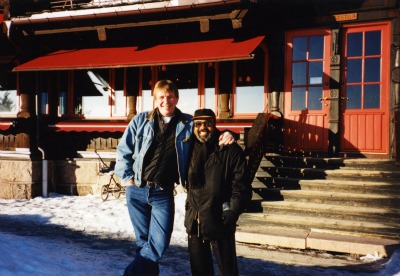
The black and white photo was taken at the jazz festival in Molde in 1979 on the gig that produced the yodel track I posted on the net.
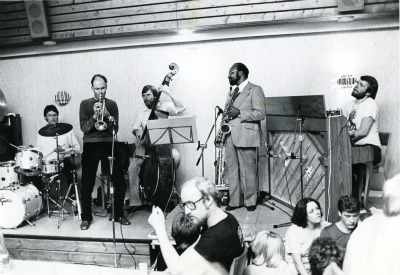
Here, with her permission, is Linda Moody's note to Mr. Husby.
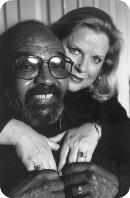
My sons and I have thoroughly enjoyed the clip of Moody. When we were first married Moody yodeled all the time and I had forgotten how good he was at that. Thank you so much. I think your letter has gone all over the Internet. 3 different people have sent it to me. By the way I am not half Norwegian. My Mother was born in Stavanger and my Father was born near Trondheim. We had a huge family reunion in Sandness in 1988.
Unlike many areas of the northern hemisphere, the Pacific Northwest has had a mild winter so far. Still, it has hardly been prime cycling weather. It was unseasonably warm today—above 60º F—so my Italian friend Vigorelli Bianchi and I hit the road. Downside: the roads and streets were scattered with gravel laid for non-skid protection when there was ice and snow. That made cornering hazardous in spots. Downside #2: there was a powerful southwest wind. On the outbound journey some of the headwind gusts had us going so slow that gravity nearly overcame forward motion. Vigorelli never complained, but my legs did.
and I hit the road. Downside: the roads and streets were scattered with gravel laid for non-skid protection when there was ice and snow. That made cornering hazardous in spots. Downside #2: there was a powerful southwest wind. On the outbound journey some of the headwind gusts had us going so slow that gravity nearly overcame forward motion. Vigorelli never complained, but my legs did.
Upside: on the homebound leg going northeast, we flew like—well—the wind. We were passing cars. It was exhilarating to be back in the saddle again.
From San Francisco comes word that trumpeter Allen Smith died last week at the age of 85. Smith's musical career got underway at the same time as those of his San Francisco State College classmates Paul Desmond, Cal Tjader, Jerome Richardson, Vernon Alley, Roberta Mandel and Dick Vartaniah. He worked with them in various bands and with other Bay Area jazz mainstays, including guitarist Eddie Duran. Although Smith's work as a musician never stopped, he fit it around his schedule as an educator who earned a masters degree and became a school principal. Smith played trumpet with Benny Goodman, Duke Ellington and Gil Evans and recorded with Ellington, Evans, Tjader, Flip Phillips and Hubert Laws among others. He was in the trumpet section on Evans' classic Great Jazz Standards album, which is included in this collection of Evans' Pacific Jazz recordings. He made his first album as a leader in 1998, when he was 72. From The San Francisco Chronicle:
bands and with other Bay Area jazz mainstays, including guitarist Eddie Duran. Although Smith's work as a musician never stopped, he fit it around his schedule as an educator who earned a masters degree and became a school principal. Smith played trumpet with Benny Goodman, Duke Ellington and Gil Evans and recorded with Ellington, Evans, Tjader, Flip Phillips and Hubert Laws among others. He was in the trumpet section on Evans' classic Great Jazz Standards album, which is included in this collection of Evans' Pacific Jazz recordings. He made his first album as a leader in 1998, when he was 72. From The San Francisco Chronicle:
Mr. Smith was a mainstay at the fabled Fillmore after-hours club, Jimbo's Bop City. Along with venerable jazz bassist Vernon Alley, drummer Earl Watkins and others, Mr. Smith helped end segregation in San Francisco nightclubs in the late '40s. He was one of the primary players at the short-lived Blanco's Cotton Club on O'Farrell Street, the city's first desegregated club in the elegant 1907 theater now called the Great American Music Hall.
"Opening a club with all-black entertaining and help, where anybody could come? That was quite radical at the time," Mr. Smith recalled in 1998.
To read the entire obituary, go here.
At a jam session a couple of nights ago, someone called "Dear Old Stockholm." I suggested that we play it in the unaltered form of the Swedish folk song that Stan Getz recorded in Stockholm 60 years ago.
The bass player said, "Huh?"
"It was a folk song?" said the pianist.
Many musicians and listeners are under the impression that Miles Davis wrote the song. There is also a general belief that it came equipped with the four bars that Davis inserted. The critic Bob Blumenthal has called that section "static chordal motion." The modification may have been at Gil Evans' suggestion when Davis recorded the piece for Blue Note in 1954. Think of the shimmering hanging chords in so many Evans orchestrations. Davis' 1956 Columbia quintet version with John Coltrane also uses the annexed section.
I argued at the session that although the static motion (I love the self-contradiction in that term) makes for greater sophistication, it sullies the simplicity and purity that attracted Getz to the tune in the first place. So, we mentally erased the four static-motion bars in the fake book lead sheet and returned the song to its original state. I'm not sure that all of the jammers went away convinced they'll play it that way from now on, but we had a good time with it.
Whoever put together the fake book gives writing credit to "Varmeland." I suppose it is possible that there is a Swedish composer named Varmeland, but if there is he didn't write "Dear Old Stockholm." The AABA melody, with its distinctive four-bar bridge, is a beloved traditional song that goes back at least as far as the early 1800s. Its name is "Ack Värmeland, Du Sköna." Värmeland, sometimes spelled Värmland, is a province in southwest Sweden on the border with Norway. It is noted for its beauty (see the picture). Here are three versions of the song, first in its unadulterated form by the imposing singer and actress Zarah Leander (1907-1981) in a 1965 television program.
possible that there is a Swedish composer named Varmeland, but if there is he didn't write "Dear Old Stockholm." The AABA melody, with its distinctive four-bar bridge, is a beloved traditional song that goes back at least as far as the early 1800s. Its name is "Ack Värmeland, Du Sköna." Värmeland, sometimes spelled Värmland, is a province in southwest Sweden on the border with Norway. It is noted for its beauty (see the picture). Here are three versions of the song, first in its unadulterated form by the imposing singer and actress Zarah Leander (1907-1981) in a 1965 television program.
Stan Getz recorded the song for the Swedish label Metronome during his 1951 tour of Scandinavia. His rhythm section was pianist Bengt Hallberg, who created an exquisite solo; bassist Gunnar Johnson; and drummer Jack Noren. When Roost issued the record in the US, Getz renamed it "Dear Old Stockholm." That recording is hard to find, but the track is available as an MP3 download. Getz's treatment of the melody helped earn him the nickname "The Sound." Getz is followed by Monica Zetterlund (1937-2005), with the brilliant accompanist Jimmy Jones on piano.
For one more interpretation among the many on record, here is the great Swedish tenor Jussi Bjorling (1911-1960) in a video illustrated with scenes of Värmeland.
On the off chance that you don't understand Swedish, here is a translation into English.
You crown jewel among Sweden's provinces
And If ever I should reach the Promised Land
I would still return to my beloved Värmeland.
I know it's something I shall never regret.
For there I want to live, there I want to die
If one day I take me a bride from Värmeland
I know it's something I shall never regret
Glad att lyssna på dig (Happy listening to you)
Teachout found video of one of the most unlikely—and most delightful—performer pairings imaginable. To see it, go to Terry's blog, About Last Night.
Then hurry back.
We in the Rifftides Department Of Language Reform realize that it has been only a year since this item ran. But it failed to change peoples' lousy usage habits, so here it is again. This time, please pay attention.
The Rifftides Department Of Language Reform (DOLR) has been neglecting its duties. Its members claim that their failure to stop the misuse of "absolutely" and "no problem" discouraged them. At a staff meeting on the subject, the DOLRers moaned that they despair of succeeding where Fowler, Strunk, White, Bernstein, Ciardi and other titans of proper English usage have failed. They pointed out that people still say, "ya know" every few seconds; still say and write, "they" when they should use, "he" or "she;" millions still bloat their sentences with "on a daily basis" and "on a national basis," wasting words when they could streamline with, "daily" and "nationally."
"Never give up," I told them. "It's God's—or Webster's—work.""Maybe we're being too fussy, too pedantic," they said. "Maybe the language is just taking its evolutionary course, and what sounds wrong today will be right tomorrow."
"Shut up and watch this," I explained.
To learn more about the poet Taylor Mali, go here. Thanks to Bobby Shew for calling this delightful wig bubble to our attention.
Language is the dress of thought.—Samuel Johnson
The great enemy of clear language is insincerity. When there is a gap between one's real and one's declared aims, one turns, as it were, instinctively to long words and exhausted idioms, like a cuttlefish squirting out ink.—George Orwell
Language is the light of the mind.—John Stuart Mill
Mechanical difficulties with language are the outcome of internal difficulties with thought.—Elizabeth Bowen
The great thing about human language is that it prevents us from sticking to the matter at hand.—Lewis Thomas
I wish people who have trouble communicating would just shut up.—Tom Lehrer
Russell Malone, Triple Play (MaxJazz). The warmth, conversational phrasing and lack of hurry in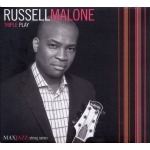 Malone's guitar work find space and congeniality in the spare background of David Wong's bass and Montez Coleman's drums. In the absence of another chording instrument to collaborate or contend with, Malone is free to make harmonic choices without concern for clash or collision. As the guitarist observes in his liner comments, Wong abets him with "great notes"..."good time" and taste. Coleman's snare drum accents and cymbal splashes color the proceedings without calling undue attention to themselves or disrupting the flow.
Malone's guitar work find space and congeniality in the spare background of David Wong's bass and Montez Coleman's drums. In the absence of another chording instrument to collaborate or contend with, Malone is free to make harmonic choices without concern for clash or collision. As the guitarist observes in his liner comments, Wong abets him with "great notes"..."good time" and taste. Coleman's snare drum accents and cymbal splashes color the proceedings without calling undue attention to themselves or disrupting the flow.
Malone's repertoire here is an assortment of his compositions, jazz tunes by others and standards. With its boogaloo inflections, his spunky "Sweet Georgia Peach" seems to allude to the pop funk of the 1970s. Like many of Malone's originals, "Pecan Pie" and "Pocketwatch" have overtones of nostalgia and reflection. He radiates joy in "Butch and Butch," a blues from Oliver Nelson's 1961 The Blues and the Abstract Truth. He revives "Tailfeathers" from Patrão, Ron Carter' 1980 album featuring Chet Baker and Kenny Barron. He lets Cole Porter's melody tell its own story as he caresses the 1939 ballad "Do I Love You?" then ends with a series of astringent ascending figures that falls away into the reassurance of a major chord. It is a typical Malone study in contrast.
More Recent Listening reviews to come.
It is known in jazz circles, particularly in New York City, that the trumpeter, composer, 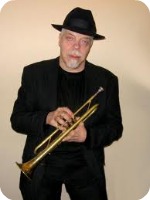 bandleader and teacher John McNeil maintains his career through the onslaught of a disease that has the potential to disable him. A lengthy profile of McNeil by journalist, educator and pianist Ben Waltzer gives insight into the disorder McNeil inherited and how he battles and accommodates its depredations. The piece, "John McNeil's Backbone," is on Waltzer's blog, A Hundred Tacks. Here is an excerpt.
bandleader and teacher John McNeil maintains his career through the onslaught of a disease that has the potential to disable him. A lengthy profile of McNeil by journalist, educator and pianist Ben Waltzer gives insight into the disorder McNeil inherited and how he battles and accommodates its depredations. The piece, "John McNeil's Backbone," is on Waltzer's blog, A Hundred Tacks. Here is an excerpt.
Typically droll and self-deprecating, McNeil reaches for humor, often of the dark sort, whenever possible. (Recovering in the hospital recently from a staph infection that only a single type of antibiotic could kill, he said, "It's showing signs of becoming totally drug resistant, at which point it'll be like the 19th century, like, 'Bye.'") But beneath his conviviality lurk strains of disharmony. McNeil is struggling. He always has.
Rediscovery, his latest recording, doesn't show it. New York Times critic Ben Ratliff called his recent playing "astonishing in its harmonic acuity." This wasn't always the case, and not for lack of talent or skill. McNeil has Charcot-Marie-Tooth disease, a painful genetic disorder of the peripheral nerves that affects muscle control.As if concocted to beset trumpet players, the degenerative condition has, among other complications, attacked his diaphragm, integral to blowing air through the horn; his facial muscles, which help produce tone and timbre; his tongue, which controls articulation; and his fingers, needed to work the trumpet's valves. The recurrence of Charcot-Marie-Tooth disease—it comes in waves—has forced McNeil to quit playing altogether several times since he came on the jazz scene in the mid-1970s. At times, he's had to use a laundry rack to support his trumpet while practicing. He had a dental bridge built to refocus his embouchure. He learned to play with his left hand, to give him an alternative when his right hand won't cooperate. And in an art that prizes timing, the degeneration of his reflexes has demanded he play slightly early so the notes arrive on time.
Now, his performing career is on the upswing again. But he remains on guard, because as long as he can remember, his body and his soul have been enemies.
To read all of Waltzer's McNeil profile, go here. Since publication of the piece, McNeil and tenor saxophonist Bill McHenry have released a successor CD to Rediscovery. Rifftides reviewed Chill Morn He Climb Jenny in December. To read the review, click here.
In case you missed it when we posted it in October, here's a live version of one of the tunes the McNeil-McHenry quartet included in that album recalling west coast jazz. It's a popular song from 1945 that Gerry Mulligan and Chet Baker recorded in the early 1950s.
As 2010 wound down, it appeared that the venerable Detroit jazz club Baker's Keyboard Lounge might be sold to someone who would make it into a dollar store. That sent a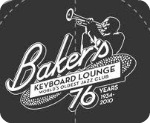 shock through the city's jazz community, which has heard major musicians at Baker's for more than three-quarters of a century. As Mark Stryker reported last week in The Detroit Free Press:
shock through the city's jazz community, which has heard major musicians at Baker's for more than three-quarters of a century. As Mark Stryker reported last week in The Detroit Free Press:
Baker's has been integral to Detroit's cultural identity as a jazz mecca for so long, it's hard for musicians, aficionados and even casual fans to conceive of the city without it. Detroit-born saxophone star James Carter*, who grew up inspired by the heroes he heard at Baker's, calls it "holy ground."
"You join this caravan of cats who have been there and made musical and spiritual contributions beyond measure," he said.
The caravan has included Louis Armstrong, Miles Davis, Dave Brubeck, Dizzy Gillespie and a parade of Detroiters who came to musical maturity in the city, among them Tommy Flanagan, Barry Harris, Pepper Adams, Yusef Lateef and Hank, Thad and Elvin Jones. Baker's got a stay of execution yesterday in a bankruptcy auction. The new owners say that they intend 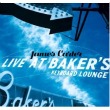 to keep it a jazz club and spiff it up. One of them said, "Baker's is a gem of Detroit and we're going to treat her as a wife. We're going to clean her up and make her feel good." To read Stryker's report on the sale and see a gallery of photos from Baker's, click here.
to keep it a jazz club and spiff it up. One of them said, "Baker's is a gem of Detroit and we're going to treat her as a wife. We're going to clean her up and make her feel good." To read Stryker's report on the sale and see a gallery of photos from Baker's, click here.
*James Carter was not only inspired at Baker's but is one of dozens of musicians who have recorded at the Lounge.
Following Stephanie Link's performance in the January 31 exhibit, perhaps you were wondering about stride piano's influence on modern jazz. Wonder no more. Kindly pay attention to Thelonious Monk's left hand.
Monk was a busy fella at the Berlin Jazztage in 1969. He played several pieces by Duke Ellington and some of his own. The Berliners also teamed him Joe Turner, not the singer but one of the last of the authentic masters of the first stride generation. Monk and Turner played a blues in honor of Ellington. Stu Martin is the drummer, Hans Rettenbacher the bassist. Turner looks as if he wonders whether he'll get his licks in, but toward the end, he does.
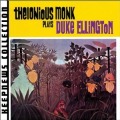 For more of Monk on Ellington, this classic 1955 album has him playing eight Ellington compositions with bassist Oscar Pettiford and drummer Kenny Clarke. It was his first album for the Riverside label, and it had a great deal to with Monk's rise from the insider's favorite jazz eccentric to general recognition as one of the music's great originals.
For more of Monk on Ellington, this classic 1955 album has him playing eight Ellington compositions with bassist Oscar Pettiford and drummer Kenny Clarke. It was his first album for the Riverside label, and it had a great deal to with Monk's rise from the insider's favorite jazz eccentric to general recognition as one of the music's great originals.
Jazz is my adventure. I'm after new chords, new ways of syncopating, new figures, new runs. How to use notes differently. That's it. Just using notes differently.
If you really understand the meaning of be-bop, you understand the meaning of freedom.
I'm famous. Ain't that a bitch!
Monk taught me more about music composition than anyone else on 52nd Street.—Miles Davis
AJ Ads
AJ Blogs
AJBlogCentral | rssculture
Terry Teachout on the arts in New York City
Andrew Taylor on the business of arts & culture
rock culture approximately
Laura Collins-Hughes on arts, culture and coverage
Richard Kessler on arts education
Douglas McLennan's blog
Dalouge Smith advocates for the Arts
Art from the American Outback
Chloe Veltman on how culture will save the world
For immediate release: the arts are marketable
No genre is the new genre
David Jays on theatre and dance
Paul Levy measures the Angles
Judith H. Dobrzynski on Culture
John Rockwell on the arts
innovations and impediments in not-for-profit arts
Jan Herman - arts, media & culture with 'tude
dance
Apollinaire Scherr talks about dance
Tobi Tobias on dance et al...
jazz
Howard Mandel's freelance Urban Improvisation
Focus on New Orleans. Jazz and Other Sounds
Doug Ramsey on Jazz and other matters...
media
Jeff Weinstein's Cultural Mixology
Martha Bayles on Film...
classical music
Fresh ideas on building arts communities
Greg Sandow performs a book-in-progress
Harvey Sachs on music, and various digressions
Bruce Brubaker on all things Piano
Kyle Gann on music after the fact
Greg Sandow on the future of Classical Music
Norman Lebrecht on Shifting Sound Worlds
Joe Horowitz on music
publishing
Jerome Weeks on Books
Scott McLemee on books, ideas & trash-culture ephemera
theatre
Wendy Rosenfield: covering drama, onstage and off
visual
Public Art, Public Space
Regina Hackett takes her Art To Go
John Perreault's art diary
Lee Rosenbaum's Cultural Commentary
